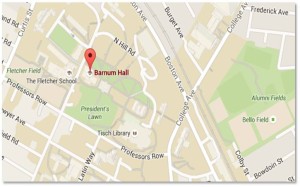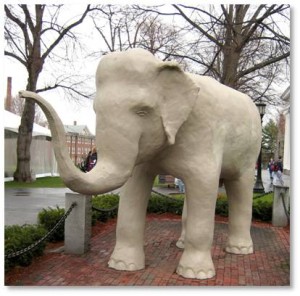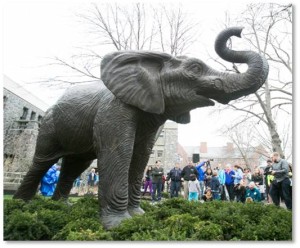To find an elephant statue in Boston, we have get creative. Once upon a time, we could find a beautiful carved head on the elephant house at the Franklin Park Zoo.
Unfortunately, that structure was demolished in 1878 after years of neglect and disrepair. I hope the African elephant head found another home somewhere and wasn’t smashed to dust but the wrecker’s ball is often not subtle.
The Tufts University Elephant
There is an elephant at Tufts University in Medford, however. Take a five-mile drive up Route 93 and you’ll find a life-size statue of an African elephant. How it got there and why involves P.T. Barnum and a real beast named Jumbo the elephant.
America’s most famous showman was also a founding trustee and benefactor of Tufts. And Jumbo was a real elephant who lived at the London Zoo for 16 years, giving “howdah” rides to little children. P.T. Barnum wanted Jumbo for his circus and acquired the elephant in 1860, paying $10,000 for him (about $240,000 today).When Mr. Barnum shipped him to the United States, it ignited a storm of outrage in England.
One of the nation’s first animal celebrities, he came to America in 1882 and sparked a “Jumbomania” fad with products of all kinds flooding the market.
Jumbo the elephant toured with Mr. Barnum’s circus for three years until he was hit by a train and killed in St. Thomas, Ontario, Canada, at the relatively young age of 24. Think of the sorrow over the recent death of Cecil the Lion and you have a small idea of how the world reacted to the demise of famous Jumbo.
Jumbo the Elephant Stuffed and Preserved
Always one to take advantage of a good marketing opportunity, Mr. Barnum saved Jumbo’s 1,500-pound-plus hide and had it stuffed. The animal’s bones were also preserved. Both traveled with the circus and were displayed in museums. Then Mr. Barnum donated the stuffed Jumbo to the Barnum Museum of Natural History at Tufts University where he remained in “Barnum Hall” for 86 years. (The elephant’s heart was purchased by Cornell.) The skeleton went to the American Museum of Natural History, where it was a popular exhibit for many years but is now in storage.
The Tufts student athletes promptly adopted Jumbo as their mascot. Unfortunately, the stuffed Jumbo burned in an electrical fire on April 14, 1975 when Barnum Hall was destroyed. Some of his ashes were swept up and put into a Skippy Crunchy Peanut Butter jar, where they remain. But the school had lost its mascot.
The Replacement Elephants
For a while Jumbo was replaced with a concrete and papier mâché statue of an Indian elephant that the Class of 1958 purchased from the now-defunct Benson’s Wild Animal Farm. That stand-in pachyderm did not meet Jumbo’s standards, however—too small, wrong species, not inspiring.
So alumnus Dick Reynolds (class of 1967) got an idea. He wanted to make a six-figure donation to his alma mater and decided to replace the amusement park elephant with a statue worthy of the original Jumbo.
Sculptor Steven Whyte started his creative process with archival photos of the original Jumbo that were taken in London and with visits to zoos before beginning the actual sculpture at his studio in Carmel-by-the-Sea, California. The finished statue was unveiled in April of 2015. It’s 11 feet tall by 18 feet long and weighs 5,000 pounds.
Although Mr. Whyte describes himself as “primarily a sculptor of people,” he created an elephant that recalls the original animal’s spirit. The new Jumbo is much more dynamic than the stuffed original or the amusement-park replacement and projects the animation of the real African elephant that was dear to the hearts of people around the world. The fact that Mr. Whyte is a British sculptor also links the two countries where Jumbo lived longest.
True to history, the statue’s tusks are short as Jumbo had broken his off against the iron bars of his cage in London and required dental surgery to repair the damage. Other alumni donated money for the installation and landscaping of the garden around Jumbo II.
The Tufts elephant may not be a Republican or affiliated with a political building, but he’s the closest thing to a Republican elephant we have here in Greater Boston.
Directions to Jumbo the Elephant
 Jumbo II lives in Jumbo’s garden outside Barnum Hall on the Tufts University campus just feet away from the lobby of the original Barnum Museum of Natural History. You can visit him at any time.
Jumbo II lives in Jumbo’s garden outside Barnum Hall on the Tufts University campus just feet away from the lobby of the original Barnum Museum of Natural History. You can visit him at any time.
Boston’s Bronze Menagerie
- Boston’s Bronze Rhinos
- Boston’s Animal Statues: Codfish
- Boston’s Horses:Paint and Henry
- Boston’s Kensington Lions
- Boston’s Bronze Teddy Bear
- Boston’s Political Animals: Democratic Donkey





What a great story!!